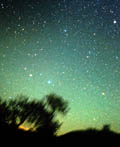|
2001 Leonids
The weather prospects in Scotland for observing
the Leonids in 2001 were very unfavourable (well - to be honest...dreadful!). Needing to
get away from Scotland for a warm break I travelled to the volcanic
island of La Palma, one of the Canary Islands located in the Atlantic Ocean off the north
west coast of Africa. Climate all year round is very pleasant; in November daytime
temperatures are around 20-23şC and around 15şC at night. Several European countries
have important optical telescopes operating on the island and the Canary Island
Government's "Law of the Sky" regulates the installation of nocturnal lighting
to minimise light pollution. As a consequence the night skies are very dark!
If only more governments were so aware of the need to preserve our night skies!
I had a delightful week on the
island enjoying the food, scenery and the fresh air. Here are some views of La Palma: volcan San Antonio,
the Valle de Aridane, Punto Gorda and the Santa Cruz barranco in spate (the car was
eventually washed into the Atlantic Ocean).
Although predicted timings for the
storms suggested that La Palma would not be privileged to see them, there was nevertheless
a slight chance that the predictions could be wrong. They weren't! Asher and McNaught's
predictions for the timings and intensities of the two storm periods were very accurate.
I awoke at around 05:00h on the
17th to do some preliminary Leonid counts- in half an hour I saw none! Unfortunately, the
weather deteriorated so that the night of the 17th/18th was completely clouded out
(ironically, the only night of our seven night stay that was cloudy!!). The next night,
the 19th, a respectable Leonid activity was exhibited from 01:00h (about 7 hours after the
storm's peak). Looking south I counted 53 Leonids between 01:00h and 04:00h (yielding a
pretty respectable ZHR of 100+). Most were around mag 2, although one, a mag. -3 bolide,
lit up the countryside and left a green train which persisted for a few seconds. Several
others rivalled Sirius in brightness. During that three hour spell I also counted 12
probable Taurids and several sporadics (it was a busy time!).
I also took the opportunity whilst
on the island to do some long exposures of Milky Way subjects.
Here are some of my images taken on
La Palma between the 19th and 23rd of November 2001.
|





